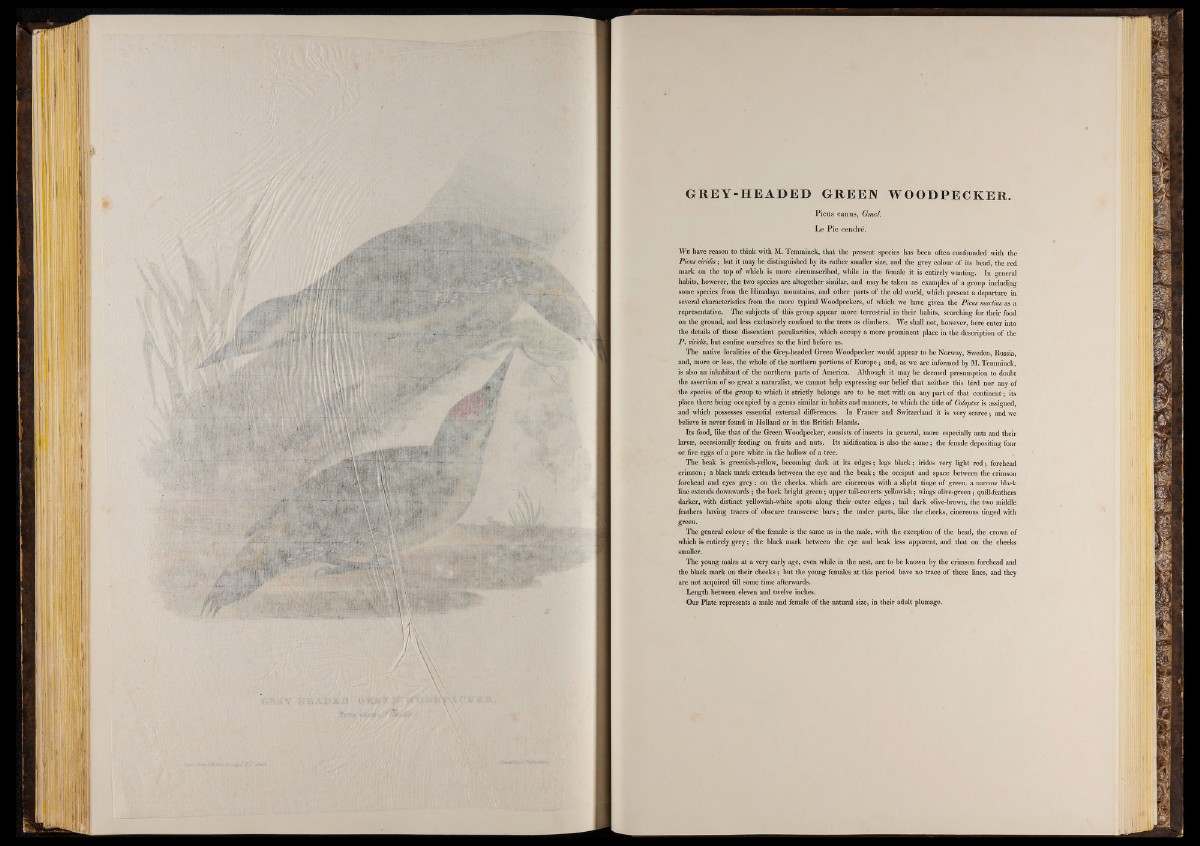
GREY -HEA DE D GREEN WOODPECKER.
Picus canus, Gmel.
Le Pic cendré.
We have reason to think with M. Temminck, that the present species has been often confounded with the
Picus viridis; but it may be distinguished by its rather smaller size, and the grey colour of its head, the red
mark on the top o f which is more circumscribed, while in the female it is entirely wanting. In general
habits, however, the. two species are altogether similar, aud may be taken as examples of a group including
some species from the Himalaya mountains, and other parts of the old world, which present a departure in
several characteristics from the more typical Woodpeckers, of which we have given the Picus martius as a
representative. The subjects of this group appear more terrestrial in their habits, searching for their food
on the ground, and less exclusively confined to the trees as climbers. We shall not, however, here enter into
the details o f these dissentient peculiarities, which occupy a more prominent place in the description of the
P . viridis, but confine ourselves to the bird before us.
The native localities o f the Grey-headed Green Woodpecker would appear to be Norway, Sweden, Russia,
and, more or less, the whole o f the northern portions o f Europe; and, as we are informed by M. Temminck,
is also an inhabitant o f the northern parts o f America. Although it may be deemed presumption to doubt
the assertion of so great a naturalist, we cannot help expressing our belief that neither this bird nor any of
the species of the group to which it strictly belongs are to be met with on any part o f that continent; its
place there being occupied by a genus similar in habits and manners, to which the title o f Colaptes is assigned,
and which possesses essential external differences. In France and Switzerland it is very scarce; and we
believe is never found in Holland or in the British Islands.
Its food, like that o f the Green Woodpecker, consists of insects in general, more especially ants and their
larvae, occasionally feeding on fruits and nuts. Its nidification is also the same; the female depositing four
or five eggs of a pure white in the hollow of a tree.
The beak is greenish-yellow, becoming dark at its edges; legs black; irides very light red; forehead
crimson; a black mark extends between the eye and the beak; the occiput and space between the crimson
forehead and eyes grey; on the cheeks, which are cinereous with a slight tinge o f green, a narrow black
line extends downwards; the back bright green; upper tail-coverts yellowish; wings olive-green; quill-feathers
darker, with distinct yellowish-white spots along their outer edges; tail dark olive-brown, the two middle
feathers having traces o f obscure transverse bars; the under parts, like the cheeks, cinereous tinged with
green.
The general colour of the female is the same as in the male, with the exception o f the head, the crown of
which is entirely grey; the black mark between the eye and beak less apparent, and that on the cheeks,
smaller.
The young males at a very early age, even while in the nest, are to be known by the crimson forehead and
the black mark on their cheeks; but the young females at this period have no trace o f these lines, and they
are not acquired till some time afterwards.
Length between eleven and twelve inches.
Our Plate represents a male and female of the natural size, in their adult plumage.